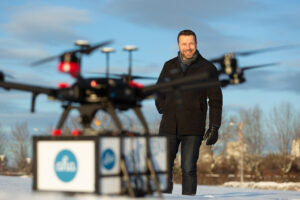
In English, a paradigm shift or major new idea may be referred to as an “Aha” moment: so the name of this innovative urban delivery service is appropriate in multiple languages. At last month’s Commercial UAV Show in London, we met Maron Kristofersson, CEO and Founder of Aha.is, a drone delivery service based in Iceland, and the accompanying UK-based software company that has developed a delivery operations solution. Aha is allowing local players to compete with retail giants on delivery. (This is the first part of a two-part series on drones and robotics in an urban environment.)
Robotics and automation, Kristofersson says, are critical to Iceland. “By way of background: weather, costs and a tight labor market in Iceland drive us toward automation… A combination of bad weather; very low unemployment; and high costs, including salaries,” contribute to the benefits and make the need for automated processes clear.
They did not start off with drones. “Initial deliveries were done using petrol cars,” explains Kristofersson, “but the high costs of maintenance drove us in 2015 toward electric cars… they are much lower maintenance and easier to operate.” Now, Aha uses a combination of technologies to make deliveries – and drones are a growing component. Drones, says Kristofersson, are “Environmentally friendly and cheaper” than traditional methods – and, he comments, despite concerns over the noise that drones create, “They are significantly quieter than cars and motorcycles.”
“We’re still at the beginning of the curve,” says Kristofersson. “Our goal is at least 50% of deliveries by drone.”
Automated Urban Delivery
In Rekjavik, Aha works elegantly and effectively. But in the future of scaled automated urban delivery, drones aren’t the only robotic systems in the process. Part of the distribution channel includes picking and packing using “robots that work immediately on order around the clock to get the product from the warehouse or store to the door,” Kristofersson explains. This robot fleet includes indoor robots that handle from store door to outdoor delivery mode; and delivery robots that are move into streets when needed.
Ultimately, Kristofersson says that last mile logistics in urban environments will be accomplished by combining technologies. “We predict that last mile logistics will be tackled by multiple delivery modes – drones, robots, autonomous cars, humans and tech we don’t know about yet – where integration is critical between the different delivery methods.”
CEO DroneLife.com, DroneRacingLife.com, and CMO of Jobfordrones.com. Principle at Spalding Barker Strategies. Has enjoyed working with and around the commercial drone industry for the last 10 years. Attendance and speaker at Industry Events such as Commercial UAV, InterGeo, Interdrone and others. Proud father of two. Enjoys karate, Sherlock Holmes, and interesting things. Subscribe to all things drone at DroneLife here. Email is Harry@dronelife.com. Make Sure that you WhiteList us in your email to make sure you get our Newsletter. Editor1@dronelife.com.